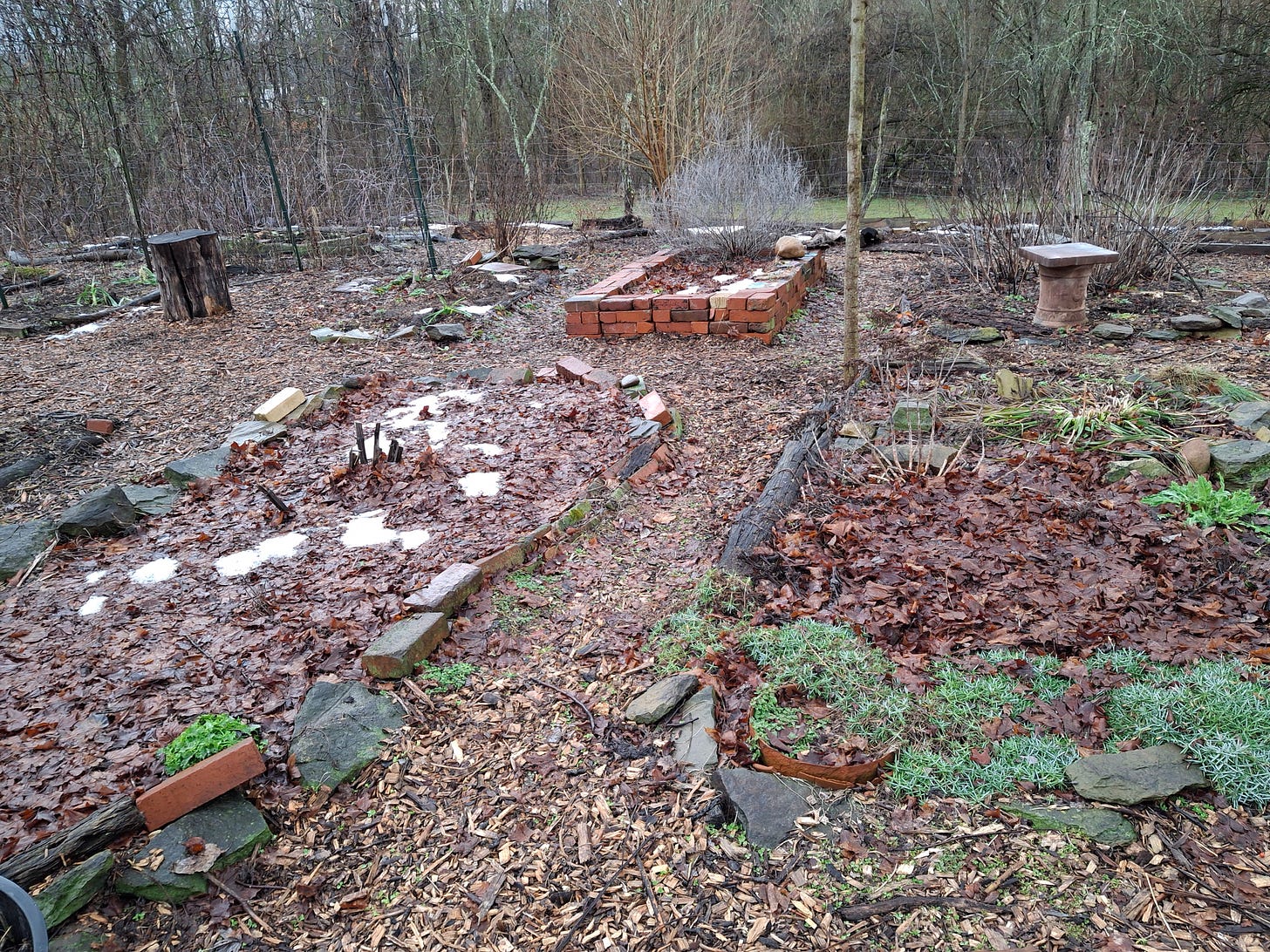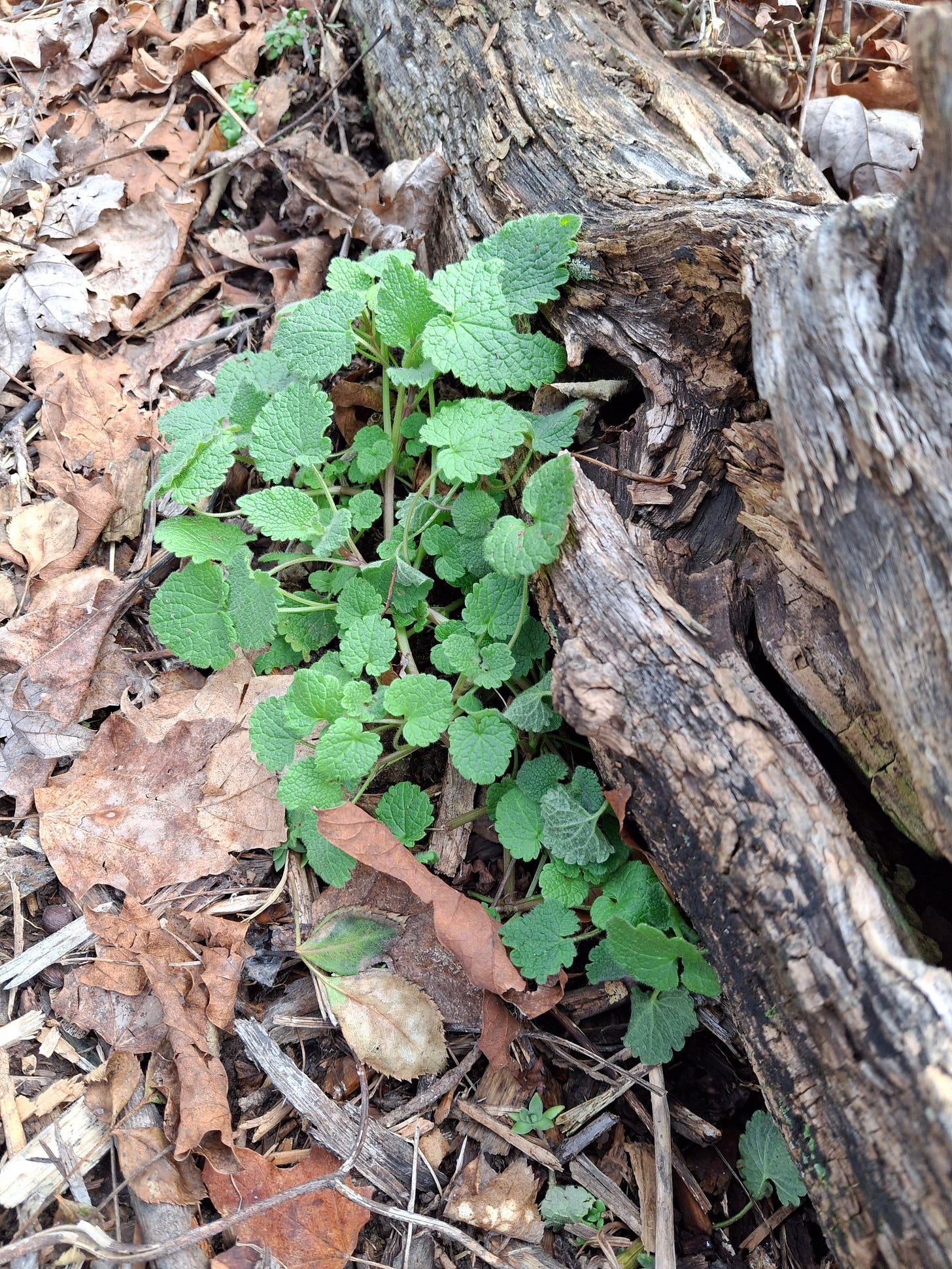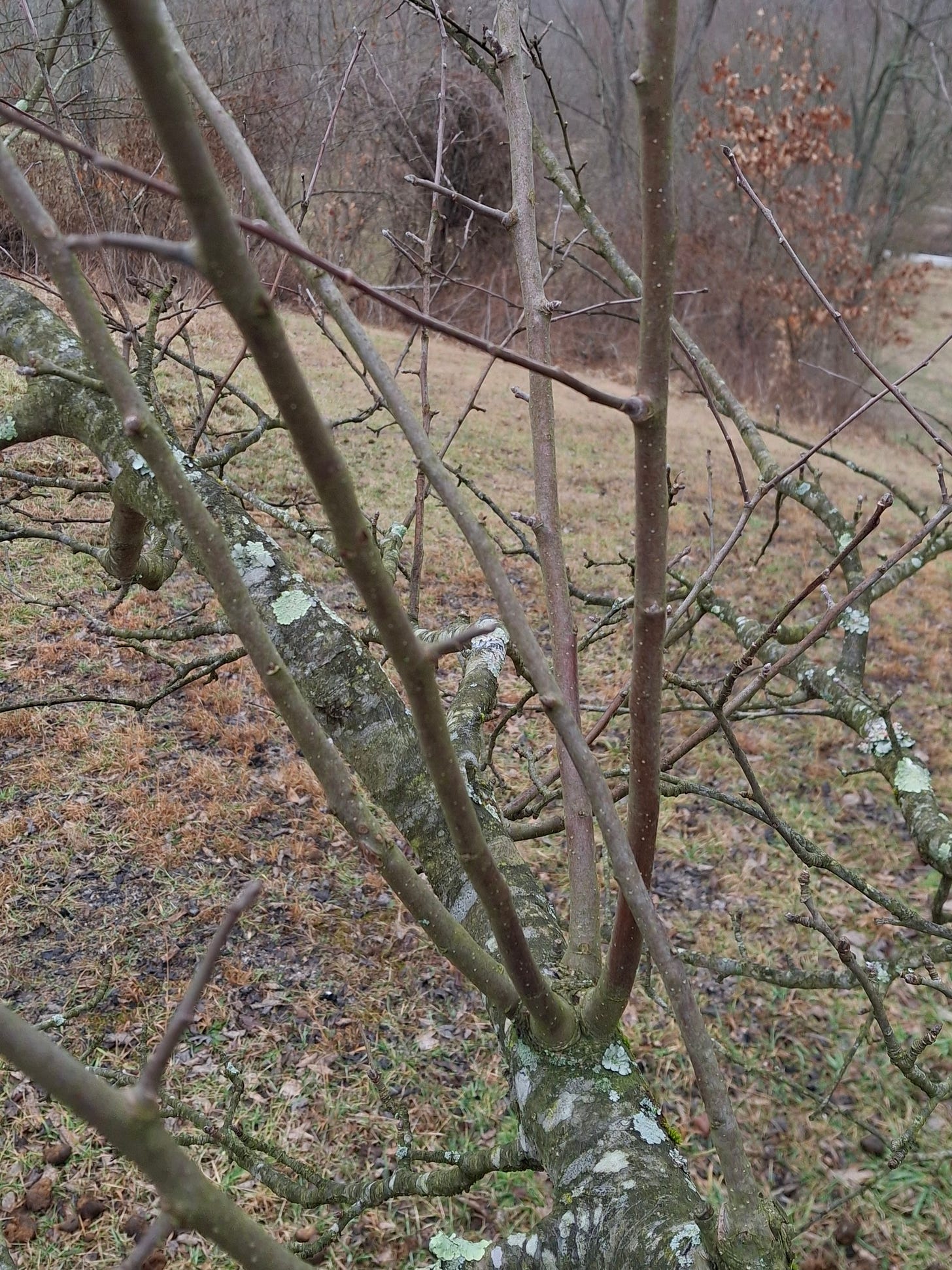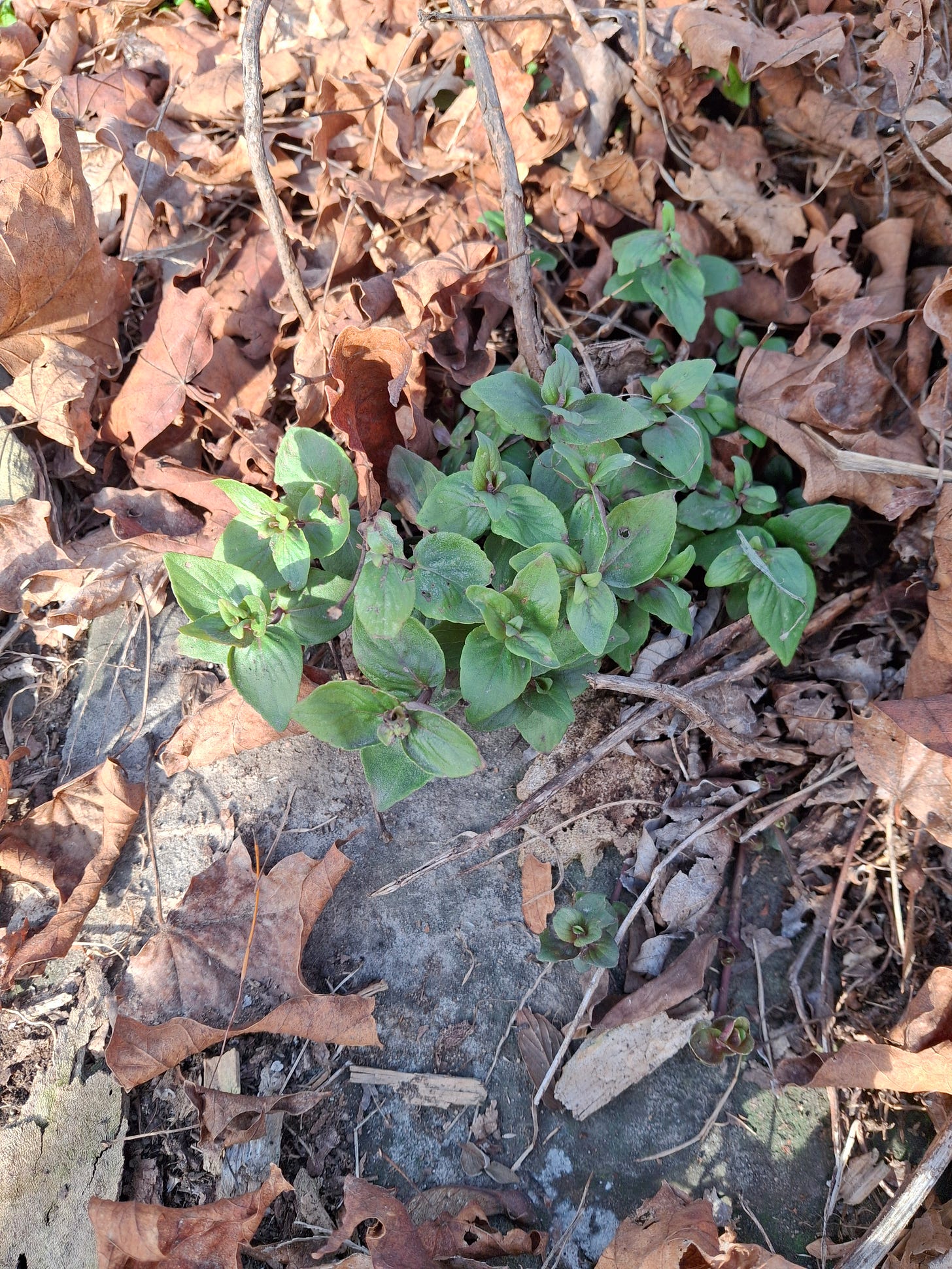Down and dirty dabbling, part 1
Using STUN to your advantage
Part 1 of a series about backyard growing without killing yourself with work
Only small patches of snow remain in the garden
We’ve had snow cover for about a month here in the Mid-Ohio Valley, but now the thaw has come and patches of dull yellow and green expand daily in the yard and orchard. Such long periods under snow have become rare here. Last winter was very warm, and the little snow that fell melted within a few days. The return of real winter has been enjoyable, but as bare areas spread, my thoughts turn to growing.
As a possible food crisis looms, it is more important than ever that more of us get involved in agriculture. A big part of this change ideally will take the form of small, diversified, commercial farms, serving local markets. However, backyard growing for one's own family and friends can also play a big part in ensuring food security.
I’m not a farmer or a market gardener, and I don’t maintain a CSA, formal or otherwise. My piece of land is the legacy farm of my grandparents, and has been referred to as “the farm” for as long as I can remember. That name sticks regardless of what is grown here, and right now the eggs, fruit, and vegetables we produce are for personal consumption.
Since I work full-time off-farm, the hours spent on garden and orchard maintenance must necessarily be limited, and over the years I've discovered techniques to minimize outdoor work while still accomplishing a lot. As days lengthen and temperatures rise, it seems time to revisit this topic. There's a cornucopia of advice about home agriculture available, much of it top notch. It’s not always possible to do things the best way, however, and it’s important to understand the difference between the minimum input necessary for success versus high imput to achieve maximum yield. If it's not clear what I mean by that, read on to find out.
Peaches are picky and therefore pampered
A useful method for getting a yield with little input is STUN. This acronym stands for “sheer, total, utter neglect.” Mark Shepard, author of Restoration Agriculture: Real-World Permaculture for Farmers, coined this term for his practice of planting crops then totally ignoring them. This might seem more like a way to kill everything rather than a sound agricultural method, but Mark Shepard has shown it can work at New Forest Farm, a commercial farm and research site in Wisconsin. STUN can be used by dabblers as well as serious farmers to minimize work while still getting a harvest.
To understand STUN, consider the two opposite extremes in plant care. I could pay top dollar for a fairly large fruit tree to plant in my front yard. I would make sure to keep it well watered and fertilized, and prune it regularly to ensure maximum yield. This option is a good one if I have lots of free time, but not much space, and if I am already familiar with pruning techniques or motivated to learn. Lots of care (high input) would most likely produce quality fruit in decent amounts.
I could also acquire lots of smaller fruit trees — or grow them from seed if appropriate, or buy cheap trees at end-of-season sales — and plant them with little preparation, then mostly ignore them. My investment is less, so it's okay if some die or take a while to produce. Practitioners of STUN often use this system to weed out weaker trees and are left with stronger ones. Even if you don’t plan on propagating the surviving trees to create superior genetics, STUN can still be useful.
Winter annuals survived unscathed under snow
A few years ago I used STUN when a friend offered me 50 loblolly pine seedlings, tiny bare-root plants about a foot tall. He had apparently received hundreds too many for his reforestation project, and sounded desperate to offload a few bundles. Loblolly isn't indigenous to southern Ohio, having a native range of Deep South and Atlantic Coast states. I’m not a stickler for planting historical natives only, however, and accepted his offer. The trees were free, and I figured eastern US native trees were better than the callery pears and autumn olives that were showing up on the Savanna (my abandoned cornfield reverting to forest.)
To plant the trees I stuck a shovel in the ground, pushed it forward to open a slit in the clay, dropped in a seedling, removed the shovel, and stomped the slit closed. I didn't go back to check on them for a few years because frankly I forgot about them. On a recent winter walk I noticed a small pine that looked a different from the Virginia and white pines common here. Its long graceful needles in bunches of three identified it as a loblolly. Further inspection of the area revealed about half a dozen surviving trees. Six out of 50 doesn't sound very good, but remember, my initial investment was nearly nothing. Barring disaster or disease, an hour or two of work will soon result in six stately pines on a west-facing slope above the river. This is a return on investment I’m happy with.
Loblolly with volunteer white pines
This type of treatment — simply sticking seedlings in the ground — is typical of reforestation plantings. Though used less often for fruit or nut trees, STUN is nevertheless an option for backyard orchardists. Part of the beauty of growing for yourself is that you can experiment with techniques, and pick and choose the parts that work for you.
Twenty four years ago I began reestablishing the orchard on the hill north of the house, where I planted a mix of fruits, mostly apple, with over 20 trees in all. Though I intended to keep them pruned as instructed in the books I had read, in few years I fell behind. Each year was worse than the last as I attempted to catch up, and spent most of my time battling watersprouts.
For those new to orcharding, water sprouts are “vegetative, vertical, vigorous growth” (according to Stark Bro’s website) that emerge from branches in response to stress. When growth begins in spring, energy stored in plant roots floods the tree. If many branches have been removed in late winter, the tree responds with rapid growth to replace them. This growth is in general weak, unwanted, and structurally bad, necessitating even more pruning to correct it. Expert pruners will avoid this situation, but it’s easy for novices to get caught in this vicious cycle.
A bad case of water sprouts on apple tree
After learning about STUN, I decided to apply it to all new fruit tree plantings, at least as far as pruning is concerned. The amount of work put into pruning wasn’t justified because it didn't translate into a huge harvest. Return on investment was abysmal. Fewer apples, or lots of small apples, is a perfectly acceptable result because I don’t need to please customers, only myself.
The STUN system isn’t doctrinaire, however, and there's no need for slavish adherence to neglect. I amend my nearly pure clay soil when planting, and provide enough water to ensure immediate survival. I also encircle young trees with fencing to prevent bucks from destroying them. Basic care to get trees established followed only by occasional inspection to remove damaged limbs and root suckers, is a good combination of care and neglect for me.
Neglecting trees is one thing, but what about other plants like annual veggies? Vegetable gardens are almost by definition high input/high yield. I lavish attention on my small plot during the growing season, while harvesting a steady stream of tomatoes, beans, zucchini, etc. Purchased plants or those started inside in late winter represent a big investment; there's too much at stake to risk STUN after spending significant time and money on precious seedlings.
There is an exception to this rule, however, and it is volunteers, the plants that simply appear in the garden. I’m not meticulous about garden clean up, and each year tomato plants pop up here and there. I don't stake them or remove suckers — it’s STUN all the way. In late summer, a treasure hunt through the chaos yields many perfect fruits, about the time the pampered plants are beginning to succumb to flights and wilts.
Mint, apparently unaffected by temp of -16F a few weeks ago
I have no investment in these volunteer tomatoes, so STUN is a good choice, as I realized when I found my first delicious volunteer tomato. You can experiment with annuals that self-sow or perennials that are easily divided, and determine by trial-and-error when STUN is a good choice for you. Experimentation can be inadvertent, as when suddenly you’re too busy to keep up with the work and the garden is left to its own devices. This can have positive results in the form of surprising yields and knowledge gained.
Those with lots of room might try transplanting excess berry canes into unused areas to see what happens. You could get lucky and have deer do the pruning for you. Asparagus crowns, herbs, or other useful perennial plants can be divided and set out, then ignored. Many novice gardeners complain about mints taking over: Harness that aggression by planting all Mentha genus members in their own area, then stepping back. If fact, anytime you find yourself annoyed at an aggressive plant, you most likely have a good STUN candidate.
Gardeners have probably always used STUN, whether purposely or by accident, but there is something reassuring about using a technique with a name. In this case, it gives you permission to stop feeling bad about ignoring plants. If you catch someone looking askance at an unkempt section of your yard, you can casually mention that it’s an experimental STUN plot. It’s a sure way to impress visitors.
STUN isn’t appropriate in all situations, but as long as your initial investment is low, it’s worth some experimentation. It is one tool in a large gardening tool shed. I’ll be spending the next few weeks in the shed, metaphorically speaking, examining the work-saving but often overlooked tools that are stored there.








I had no idea there was a name for my favorite gardening technique.
It's easy to read this post and miss what, to me, was it's most urgent remark. It comes off as almost a throw-away line: "As a possible food crisis looms...." I want to ask what you meant by that. I was especially struck by this word choice because of all the gloomy political news I've been reading the last few days. There seems to be a coup going on in America. Even the near future feels very uncertain to me right now.
I'm amazed that you do all you do with a full-time job, farm maintenance, permaculture experiments, horses, chickens, turtles, pesky rodents, and a regular column too. It's impressive. I enjoyed that you're espousing "sheer total utter neglect" as a methodology that I can enthusiastically embrace, and thrilled to hear there is "no need for slavish adherence to neglect," which means I can occasionally enjoy being a decent father.
As a city person, it was hard not to read your essay as an analogy to raising children. I think my wife and I were close to being helicopter parents, but I've known a whole bunch of STUN kids in my time too, and a lot of them turned out quite well, thank goodness, and is sort of a testament to the old adage: "what doesn't kill you makes you stronger." When I looked this up just now, I was surprised to find out this was originally a quote from Nietzsche, but it sounds like it might have originated with a gardener.